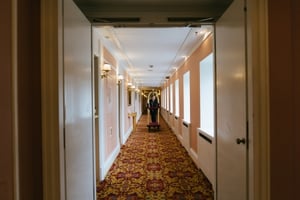The future of hotel design
What’s Next for Hotels: 4 Top Trends
 Necessity may still be the mother of invention - but the shared experience of a global pandemic has accelerated invention’s implementation across the hotel landscape. “Much of what is top of mind now, like contactless technology, was already something we had well underway, but now it’s getting in market faster,” according to Brian Flick, vice president of operations for Compass Group, which saw the recent opening of a pioneering dual-brand Marriott project on Amelia Island, Florida.
Necessity may still be the mother of invention - but the shared experience of a global pandemic has accelerated invention’s implementation across the hotel landscape. “Much of what is top of mind now, like contactless technology, was already something we had well underway, but now it’s getting in market faster,” according to Brian Flick, vice president of operations for Compass Group, which saw the recent opening of a pioneering dual-brand Marriott project on Amelia Island, Florida.
Future-forward hotels are competing for business by accommodating travelers in new ways, driven by these top trends:
-
Don’t Touch. Whether it’s a keypad code, a digital version of a room key, or a smartphone app, eliminating the need for physical room keys speaks to safety while streamlining the check-in process. Keyless entry systems integrated with hotel software allow guests to control their experience and contribute to building loyalty.
-
Mix Business and Pleasure (and Life.) Reporting on the second quarter of 2021, Marriott’s Chief Executive Officer Anthony Caputo said, along with seeing demand step up significantly, “We are seeing more blending of trip purposes, a trend we expect will continue.” With guests working and learning remotely during the pandemic, the tether to the office loosened up, leading to greater travel flexibility paired with pent-up demand.
-
Make It Multipurpose. To accommodate the new ways of using hotel space and the rise in longer stays, hotel designers are looking to create an environment that meets more than the basic lodging needs. At the Courtyard and Springhill Suites by Marriott on Amelia Island, both hotels have expansive lobbies and spaces including ‘meeting pods’ along with ample charging for electronic devices (paired with a Starbucks in the Courtyard Lobby.) A hotel can now be an entertainment and dining venue, a workspace, schoolroom, gathering place, wellness center, and more.
-
Add Local Flavor. The multipurpose approach calls for ways to bring the uniqueness of place inside hotel walls. New generations of hotel brands are moving away from cookie-cutter could-be-anywhere properties to designs that provide guests with a curated local experience. The Amelia Island Courtyard and Springhill Suites incorporates its surroundings from the wall decor, use of natural light, the names of its meeting rooms to the specialty food and drink on its Tidewater Pool Bar & Grill menu (fortunately for Executive Chef and Director of Food and Beverage Niko Anagnostou, the area’s offerings of seafood and Southern-inspired flavors are delicious and expansive.)
As Marriott’s Global Design manifesto states: “From planning and drafting to physical development, hotel design strives to connect with a traveler. It tells an inimitable story, making the guest feel both comfortable and awed.”
